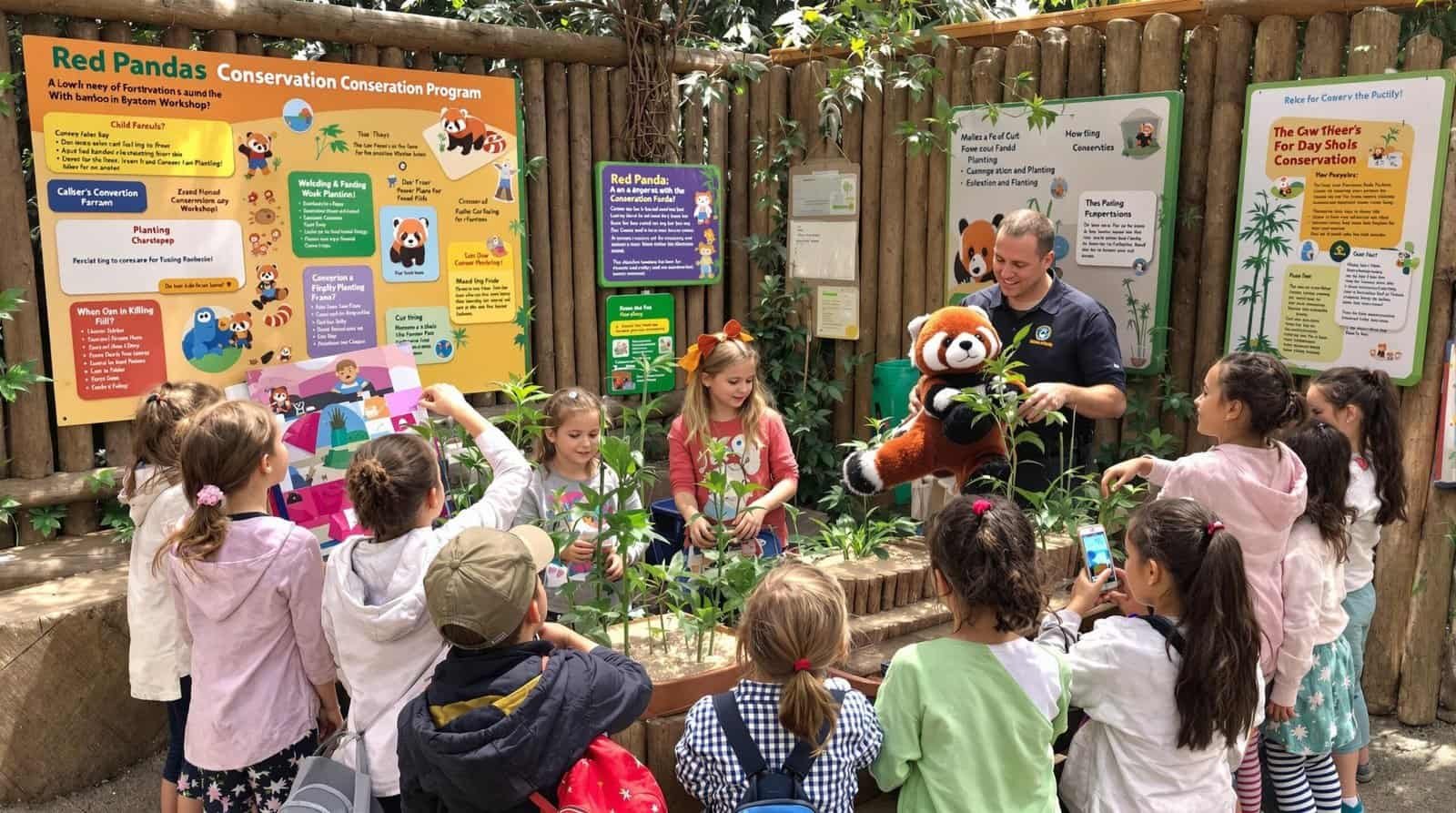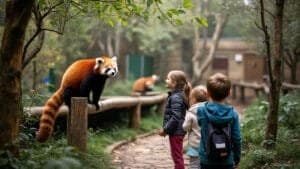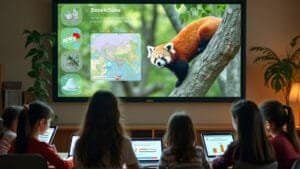Introduction
Red pandas, with their endearing appearance and ecological importance, play a unique role in conservation education for children. Their charm captures young audiences’ attention, making them effective ambassadors for teaching biodiversity, habitat preservation, and sustainable practices
Through zoo programs, classroom collaborations, and interactive activities, red pandas inspire curiosity and empathy, fostering a lifelong appreciation for wildlife
This article explores the role red pandas play in conservation education, highlighting the creative ways they are used to engage children and encourage eco-friendly behaviors
Why Red Pandas Are Ideal Ambassadors for Conservation Education
Red pandas serve as compelling ambassadors in conservation education programs for children due to their unique appearance, ecological importance, and ability to spark curiosity and empathy
By connecting with children on an emotional level, red pandas effectively introduce complex topics like biodiversity and habitat preservation in an engaging and accessible way
The Appeal of Red Pandas to Children
Red pandas have an irresistible charm that naturally draws the attention of young audiences. With their soft fur, bushy ringed tails, and playful demeanor, they are often perceived as “cute,” making them instantly relatable and memorable
Children’s fascination with red pandas creates an ideal entry point for teaching broader conservation concepts
This appeal is amplified in educational settings, where red pandas are frequently featured as the stars of programs or exhibits. Their small size and gentle nature allow children to connect with them more easily than with larger or more intimidating animals like lions or bears
These connections foster a sense of wonder and excitement, making children eager to learn more about red pandas and their habitats
Red Pandas as Symbols of Biodiversity and Environmental Balance
Red pandas are often used to represent the importance of biodiversity and ecological balance. Native to the temperate forests of the Himalayas and parts of China, red pandas depend on healthy ecosystems, particularly bamboo forests, to survive
Teaching children about red pandas naturally leads to discussions about the interdependence of species and the need to protect entire ecosystems
For example, children learn that preserving bamboo forests benefits not only red pandas but also other species, such as birds, insects, and herbivores, that share their habitat
This holistic approach helps children understand that conservation efforts must address entire ecosystems rather than focusing solely on individual species
Through red panda programs, children also gain an appreciation for the role humans play in protecting these ecosystems. Topics like deforestation, climate change, and sustainable living are introduced in ways that highlight how small actions can have a big impact on species like the red panda
How Red Pandas Foster Empathy and Curiosity in Kids
Red pandas’ playful and gentle behaviors make them relatable to children, fostering empathy and a sense of responsibility for their well-being
Educational programs often emphasize the challenges red pandas face in the wild, such as habitat loss and poaching. These stories evoke compassion and inspire children to think about ways they can help
Moreover, red pandas spark curiosity about wildlife and the natural world. Children are often eager to learn fun facts about red pandas, such as their bamboo diet, climbing abilities, or vocalizations
This curiosity lays the foundation for broader environmental education, encouraging kids to explore topics like wildlife biology, conservation science, and sustainable practices
By capturing children’s imaginations, red pandas create an emotional and intellectual connection to conservation efforts, ensuring that young audiences remain engaged and motivated to protect the environment
Incorporating Red Pandas Into Children’s Education Programs
Red pandas are a cornerstone of many conservation education programs for children, especially those offered by zoos, schools, and environmental organizations
Through hands-on activities, creative storytelling, and engaging collaborations, these programs introduce young audiences to the importance of wildlife protection and sustainable living
Zoo and School Collaborations: Teaching Conservation With Red Pandas
Zoos frequently partner with schools to bring conservation education into classrooms, using red pandas as a central theme
These collaborations include field trips to zoo exhibits, where students can observe red pandas in naturalistic habitats while learning about their behaviors, diet, and conservation status
Educational workshops conducted by zookeepers or educators often include interactive components, such as discussing how habitat destruction affects red pandas and brainstorming solutions to protect their ecosystems
In some programs, students can participate in activities like designing posters or presentations to advocate for red panda conservation
Virtual programs are also becoming popular, allowing schools to connect with zoos remotely. Live-streamed red panda feedings or behind-the-scenes tours offer students a chance to engage with wildlife from their classrooms, making conservation education more accessible
Interactive Activities for Learning About Red Panda Habitats
Hands-on activities are a powerful tool for teaching children about red pandas and their habitats. Many conservation programs incorporate crafts, games, and workshops to make learning enjoyable and memorable
For instance, children might participate in a “bamboo planting” activity, where they learn about the importance of bamboo to red pandas and simulate planting it in a model forest. Similarly, scavenger hunts at zoo exhibits encourage kids to identify features of red panda habitats, such as climbing structures or shaded areas
Games like habitat-building puzzles or role-playing activities, where children act as conservationists managing a red panda reserve, teach problem-solving skills while highlighting real-world challenges
These activities not only make learning fun but also help children internalize key concepts about conservation and environmental stewardship
Using Red Panda Stories, Games, and Mascots to Teach Sustainability
Red pandas are frequently featured in stories, games, and mascots designed to engage children in conservation themes
Picture books and animated stories about red pandas often incorporate lessons about protecting nature, emphasizing themes of teamwork, empathy, and the importance of preserving habitats
Mascots based on red pandas are used in campaigns and educational events to create a friendly, approachable image for conservation efforts. These mascots, often present at zoos or community events, interact with children through photo opportunities, games, and storytelling sessions, making the learning experience more dynamic
Digital games and apps featuring red pandas are another popular method of teaching children about sustainability
These games might involve caring for a virtual red panda, solving conservation challenges, or exploring digital environments that mimic their natural habitats. Such interactive tools make it easier to convey complex ideas in an age-appropriate and engaging format
By incorporating red pandas into a variety of educational settings and activities, conservation programs ensure that children develop a strong connection to wildlife and an early appreciation for the importance of protecting our planet
Encouraging Eco-Friendly Behaviors Through Red Panda Programs
Red panda conservation education programs are designed not only to inform children about wildlife but also to inspire them to adopt eco-friendly habits
By teaching sustainable practices and fostering a sense of responsibility, these programs empower young participants to take meaningful action to protect red pandas and the environment
How Red Panda Education Promotes Habitat Preservation Awareness
One of the central goals of red panda conservation programs is to highlight the importance of preserving natural habitats
Children learn about the role of bamboo forests in supporting red pandas and the broader ecosystem, gaining an understanding of how deforestation, farming, and climate change threaten these critical environments
Programs often incorporate hands-on activities to reinforce these lessons. For example, children might create models of forest ecosystems, identifying how red pandas and other species depend on healthy habitats to survive. These activities emphasize the interconnectedness of ecosystems and the need for holistic conservation efforts
Educational materials also encourage children to think about how their daily choices impact the environment
Topics like reducing paper waste, recycling, and supporting sustainable products are introduced in the context of protecting red panda habitats, helping children make connections between their actions and global conservation efforts
Inspiring Kids to Take Action for Wildlife Conservation
Red panda programs often include opportunities for children to take direct action in support of conservation. Activities such as fundraising drives, letter-writing campaigns, or participating in local habitat restoration projects give kids a tangible way to contribute
For instance, children might organize bake sales or craft fairs with proceeds donated to organizations like the Red Panda Network. These activities not only raise funds but also instill a sense of accomplishment and empowerment
Another effective approach is encouraging children to become “Red Panda Ambassadors.” In this role, participants pledge to share what they’ve learned about red pandas with friends and family, spreading awareness and inspiring others to care about wildlife conservation
Programs may also involve kids in citizen science initiatives, such as helping to monitor local biodiversity or participate in tree-planting events. These experiences provide real-world context for the lessons taught in conservation programs, fostering a lifelong commitment to environmental stewardship
Success Stories From Red Panda-Themed Conservation Programs
Numerous red panda conservation education programs have successfully inspired children to embrace eco-friendly practices and advocate for wildlife protection
One example is the “Red Panda Ranger” program organized by the Red Panda Network. This initiative engages children through educational challenges, such as learning about red panda habitats or creating posters about conservation
Participants earn certificates and recognition for their efforts, motivating them to continue learning and taking action
Similarly, zoos like the Woodland Park Zoo in Seattle host annual “Red Panda Day” events, featuring activities like habitat-building workshops, zookeeper talks, and interactive exhibits. These events have drawn thousands of participants, raising awareness about red panda conservation while encouraging sustainable behaviors in everyday life
By combining education, action, and inspiration, these programs ensure that children develop a lasting connection to red pandas and a deeper understanding of their role in protecting the planet
Conclusion
Red pandas serve as invaluable ambassadors for conservation education programs designed for children. Their adorable appearance and unique behaviors captivate young audiences, creating a powerful entry point for teaching critical topics like biodiversity, habitat preservation, and sustainability
Through interactive activities, storytelling, and hands-on learning experiences, these programs foster empathy and inspire a lifelong appreciation for wildlife and the environment
By encouraging children to adopt eco-friendly habits and engage in conservation efforts, red panda programs go beyond education to empower action. Success stories from initiatives like the “Red Panda Ranger” program and zoo-based events demonstrate the positive impact these efforts can have on shaping the next generation of environmental stewards
As red panda conservation education continues to evolve, its influence on young minds ensures a brighter future for both these charismatic animals and the ecosystems they call home
With sustained efforts, children today can become the champions of tomorrow, working to protect red pandas and the planet for generations to come









